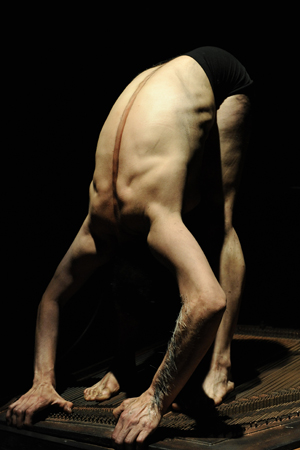
With Head VI, Masque research had faced Francis Bacon’s work through Gilles Deleuze’s ideas. Here, it concentrates on Kafka’s work. And here, again, with the support of the french philosopher and a work written together with Felix Guattari: Kafka: toward a minor literature.
A motionless presence dominates the space.
On the eviscerated body of a piano, the sounding board is an area of reclusion for the actor. Bed, prison. Cell, precisely. Then, the sound is generated by Eleonora’s movement- she is female and beast here- with a quick and calm movement that will be binary, that will have an elementary nature. This scenic note taken by Masque comes from the reading of Kafka made by Deleuze. This note bases itself on the idea and the possibility of sound’s autogeneration. Here, the tragic boby of the scene is matched by the ludic one too. After a long, tenacious and rigorous walk, Masque is now able to cross the threshold of lightness. The use of an interactivity that turns to dramaturgic speech but also to levity shows this lightness.
Lorenzo Bazzocchi doesn’t like “ludic”, but if this word is used with decency, it will reveal the awareness of a game. Deleuze taught us the relation of fluidity between couples of opposites, smooth and streaked space, nomadic and sedentary, body and machine. Masque inherits this relation’s semiotic circularity, the machine writes on the body and the body writes on the machine. I remember that wonderful fragment from “Corpus” by Jean-Luc Nancy, who has already represented a guide for me during some radical breaks, failures: “We don’t know which “writings” or which “escriptions” will come from these places. Which diagrams, which networks, which topological insertions, which geographies of multitudes. It’s time to write and think about this body in the infinite distance that makes it our body, that lets it come here from a long way off, from a very long way from all our thoughts: a body that is exposed to the whole world’s population”. Isabella Bordoni
In Kafka’s machine the protagonist is the beast. Like in “The Burrow”. But here the animal doesn’t drive flags to define its territory. It holds on. It waits for the oncoming danger to become real. Just then, it’ll be able to fight with its own weapons: the power of the sound, the acoustic impact, the memory tinnitus.
The work of masque is conceptually influenced by the ideas of the two French philosophers: the concept of minority and territory, of multiplicity and becoming.
Kafka’s machine still remains the setting of exercise, of the search for a type of acoustics that averts melody and works through intensity and frequency glissandos: a deterritorialized sound coming out of the instrument, created with the purpose of becoming part of an indefinable mass of sound, eternally doomed to change.
Working on the masses of sound from inside leads to reflecting on the matter of the minor as the work of deconstruction, a dark work between machines, “entre automatas”. On one hand the harp, the tormented instrument, the demolished piano, and on the other the disklavier, a powerful notes reader. In-between, the living translator, a human being who transcends his humanity to be at the service of pure sound. A sound that lives for itself, autonomously, beyond the restraints of melody and harmony, coming down impetuously from the high and going up again. The sound produced by the “woman-desklavier” machine is finally as overwhelming as a sea storm.
The space where this operation of sound liberation takes place (we abhor equable temperament!) is the performer’s body itself: the shoulders represent the velocities (the volumes), the face represents the heights (the frequency), the hands represent the notes’ length.
Eleonora becomes a “territorial creature”, whose real aspect is generated by the rhythm of variable intensities and by the glissandos. A strong feedback is created: the sound mass works to define the real nature of the woman by whom it was generated.